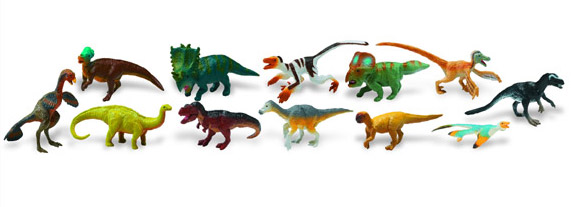Little Feathered Monster from the Jurassic – Epidexipteryx
The fossilised remains of a bizarre pigeon-sized feathered dinosaur have just been described in the scientific journal “Nature” The dinosaur has been named Epidexipteryx. A number of feathered dinosaurs have been unearthed in recent years, most notably from the Cretaceous sediments of Liaoning Province, China. A number of small, theropod dinosaurs have been excavated from this area, many show feathers or fibrous coats over parts of their bodies. Some of these little feathered predators had long, branching feathers on their arms and tails, an example of this would be Caudipteryx known from several nearly complete skeletons all excavated from the Liaoning area. These long feathers, would not have been designed for flight but more probably used for display – perhaps to attract a mate or frighten off a rival.
Epidexipteryx
Now this new discovery, puts the origin of such bird-like dinosaurs another 30 million years into the past. The Liaoning discoveries are dated from the Barremian faunal stage of the Early Cretaceous (130 -125 million years ago). The fossil of this new feathered dinosaur, named Epidexipteryx dates from much earlier, approximately 168 – 152 million years ago, making this little creature one of the earliest dinosaurs with feathers known. Epidexipteryx probably dates from before the time of Archaeopteryx, the famous “first-bird” known from a handful of fossils from the famous Solnhofen deposits in Germany.
Study of the fossil specimen has shown that this little dinosaur had affinities with the oviraptorids – a group of extremely bird-like dinosaurs. Indeed, some scientists have stated that this particular group of dinosaurs should be reclassified as avian dinosaurs. Epidexipteryx possessed four long tail feathers that grew out of a pygostyle (compressed caudal vertebrae, the remnants of a reptilian tail still seen in birds today). These feathers would have probably been used for display purposes, reinforcing evidence that these dinosaurs had excellent colour vision. The presence of the tail feathers may indicate complex, social interactions and sophisticated behaviours, reminiscent of many bird courtship displays seen today.
Researchers, who named the “bizarre” dinosaur Epidexipteryx hui, dated it to between 152 million and 168 million years ago, in the Jurassic period, though they said that it could be considerably older.
The Chinese scientists who discovered the fossil found that it shared characteristics both with primitive birds and dinosaurs, indicating that it represented a stage in evolution between the ancient reptiles and modern avians. Analysis of the fossil, found in Daohugou, Inner Mongolia, suggested that the dinosaur was flightless and would have scampered along on its hind legs. Weighing less than a bag of flour, this little dinosaur would have scampered through the undergrowth, preying on insects, mammals, small reptiles and salamanders. The strong, three-fingered hands would have grasped the prey and the sharp teeth located at the front of the mouth would have soon dismembered any animal that dared venture into the path of this voracious hunter. The presence of feathers indicates a warm-blooded metabolism (endothermic) and this little dinosaur would have had to feed regularly to maintain its high metabolic rate.
Bizarre Feathers
Among the surprises for the research team were long ribbon-like tail feathers, suggesting that the creature was male, such ornamentation in modern birds are often sexually dimorphic, for example in peacocks, the male has a spectacular tail feather display whilst the female (peahen) is very plain in comparison. Similar feathers in modern birds are used for display. Researchers from the Chinese Academy of Sciences in Beijing commented:
“Ornamental plumage is used to send signals essential to a wide range of avian behaviour patterns, particularly relating to courtship. Experiments have shown that, in some species, males with long tail plumage attract more mates than short-tailed counterparts. It is highlyy probable that the [elongated tail feathers] of Epidexipteryx similarly had display as their primary function.”
Dr Fucheng Zhang of the Academy went on to state: “This is very exciting indeed, since it gives us a window into a stage of avian history just preceding the evolution of the classic “first bird” [Archaeopteryx]”.
Feathered types of dinosaur are very much in vogue, although the number of fossil specimens with feathers is still limited (by far the greatest amount of evidence is from the sites in and around Liaoning province in China), a number of types of dinosaur are associated with proto-feathers as well as asymmetrical and symmetrical feather types including oviraptorids, ornithomimids, therizinosaurs and the alvarezsaurids, as well as the dromaeosaurs.
The American Museum of Natural History produced a tube of dinosaur models, many of which were feathered, included in this set are models of Microraptor, Velociraptor, Dilong and Caudipteryx.
Feathered Dinosaur Tube: Dinosaur and Prehistoric Animal Models.
The Feathered Dinosaur Set (American Museum of Natural History)
Picture credit: Everything Dinosaur







Leave A Comment